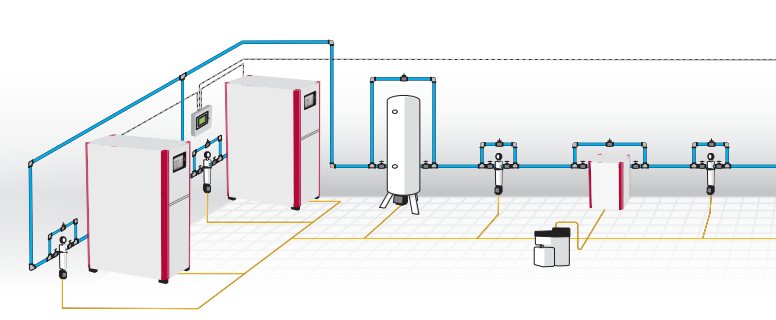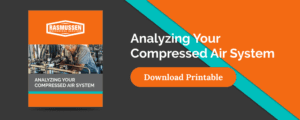It can be tough to determine where to start when designing a piping layout structure that’s right for you. While the compressor is an integral part of your facility, the piping will make or break the system. To help make your decision process easier, we’ve put together some valuable information on compressed air piping systems to aid you throughout the process.
THE PIPING SYSTEM AND COMPRESSED AIR
An air compressor is a device that transfers power using an electrical, diesel, or gasoline engine, in the form of compressed air. Piping systems bring together every element of your compressed air system and can make or break a system. That is why it’s essential for building managers to pay attention to the layout and design of their piping. Strides have been made in recent years on piping material used for compressors. An article by ecompressedair says;
“These (new) compressed air piping systems typically have smooth walls, are lightweight, and reduce the installation costs associated with copper and threaded pipe.”
While choosing the correct compressed air piping is important, understanding how to lay out the piping is imperative.
Piping Layout Considerations


Before designing your compressed air piping system, its critical facility leaders focus the design around the compressed air system’s connectors. After all, leaks are likely to occur within your connectors, which can be your facility’s biggest threat if not fixed properly.
Other factors to consider that can have a significant impact on your piping system’s pressure efficiency and leakage are:
- Sharp Angles
- Water
- Obstructions and Blockage
1. SHARP ANGLES
If sharp angles are present throughout your piping system, this could severely impede the flow speed, resulting in reduced pressure. As air flow emerges from out of a bend, it often becomes turbulent. This is the opposite of the “laminar flow” you are looking for and results in wasted energy.
Did you know: Turbulence caused at a 90-degree bend results in about 3 to 5 PSID of pressure loss?
Facility leaders will want to ensure there’s a straight path for airflow. Excessive turbulence can cause major pressure drops and decrease your piping system’s pressure efficiency.
2. WATER
Throughout most piping systems, water will corrode certain types of pipes, resulting in rust to flake into the pipe’s air stream. The water that transpires from the compression starts when air is taken in by the compressor when ambient air is presented.
Rust starts at the at your end-use equipment and can:
- Clog nozzles
- Contaminate the material used for the compressed air to deliver or apply
- Create a rough surface from the corroded interior of the rusted pipe
The buildup of moisture is unavoidable, but you can manage it. One solution to change the supply inlet source where the air is being drawn in. Water from the compression is normally heavier than the compressed air itself, causing it to fall towards the bottom of the compressor. That’s why it’s important when air draws in, it’s distributed from the top of the compressor. This will result in taking in less moisture, and having less buildup.
Drying the air before it enters the compressor is an even more effective means of reducing moisture. This will require you to pass your airflow through driers which can slow down the airflow and reduce pressure.
Did you know: Removing moisture from your airflow early on allows your air to circulate in the piping more easily.
To alleviate this task, many compressor installers will require you to use an aftercooler. The aftercooler cools the air when it leaves the compressor, so a majority of the moisture will leave before it heads into the piping. Once it heads into the piping, the air feeds into a filter with a drain to remove the liquid from the system. When air goes through the aftercooler’s filters, you will see less moisture in your airflow immediately, once it has left the compressor.
3. OBSTRUCTIONS
Additionally, in many piping system’s infrastructures, corrosion can be a major issue. If presented, corrosion in your piping system can break off and generate obstructions throughout your system.
Many obstructions occur in your piping’s:
- Valves
- Connectors
- Dryers
- Sensors In The Circuit
If any obstructions occur in these elements, it causes a reduction in the pipe diameter. This creates a bottleneck and reduces air flow. It lowers the amount of available pressure when air flows downstream, and back up pressure when air flows upstream.
One solution to handle air particles building up in your system is by using and regularly replacing air filters. It’s essential to have air filters in the compressor, so they are able to remove hazardous particles that might circulate throughout the piping. This prevents clogging devices such as the valves and end-use nozzles.

Types of Piping Material
You may be asking yourself, “Which type of piping is best for my system?” If you aren’t sure where to start, we suggest either plastic and metal piping.
Plastic Pipes
If you’re thinking about purchasing plastic pipes, there are many benefits to them including:
- Non-corrosive, meaning rusting won’t be a problem with your airflow, reducing the risk of obstructions.
- The interior is smooth and doesn’t deteriorate, which encourages laminar flow.
- Plastic pipes are lightweight and easy to transport.
- You can cut through plastic pipes easily and quickly that requires basic tools.
- Plastic pipes can be glued together which is quicker than welding and reduces installation costs.
The most common types of plastic pipes available are polyvinyl chloride (PVC) and chlorinated polyvinyl chloride (CPVC). PVC and CPVC pipes are commonly in use for plumbing applications. They should not be used for high-pressure systems.
Another source of good materials for piping is acrylonitrile butadiene styrene (ABS), polyethylene (PE), and high-density polyethylene.
Con: In some situations, PVC and CPVC have caused a number of incidents. The Occupational Safety and Health Administration (OSHA) banning them for use in high-pressure systems.
Pro: ABS, PE, and HDPE are all OSHA approved in the use of compressed air piping.
Lubricating Oil In Plastic Pipes
Understanding lubricating oil is as important as selecting the right plastic piping material.
Con: Lubricating oil is corrosive to PVC and CPVC pipes. This causes the pipes to degrade in compressed air applications, splinter, and cause injury to facility members, resulting in loss of production.
Pro: ABS, PE, and HDPE pipes are oil-resistant and won’t degrade when in contact with lubricants.
There are still some concerns when it comes to purchasing plastic piping. Some mechanical professionals believe plastic piping isn’t viable because of the cement in the connectors isn’t strong enough and could cause leaks and bursts. When using plastic pipes, always ensure testing and approval by OSHA.
Metal Pipes
Many mechanical professionals, they’ll tell you they prefer metal pipes for a compressed air piping system. Why, you may ask? Many believe the look and feel of metal pipes are more reliable, stronger, and safer than plastic pipes. Some benefits of metal pipes are:
- Traditional material means more installation technicians know how to fit the pipes.
- Having been in service longer than plastic pipes, metal pipes are stronger against blowouts, fractures, and splits.
- Their rigidity is proven against warping.
- Compressor lubricants won’t alter or degrade metal pipes.
There are 5 main categories of metal pipes:
1. Black Steel Pipe
Pros: The black steel pipe is traditionally used throughout a compressed air system. Not only is it strong and durable, but many technicians are familiar with its installation.
Cons: It’s susceptible to corrosion. If pipes are suspended, they’ll need a strong anchor due to its heaviness. Since they’re normally heavy, it’s harder to cut and join them together.
2. Galvanized Steel Pipe
Pro: Less susceptible to corrosion.
Cons: The galvanized steel pipe’s coating tends to flake over time, which causes blockages and harm when released in the air stream. It also is difficult to maneuver. Threaded or welded joints are prone to failure, and requires a higher strength from suspension due to their weight.
3. Stainless Steel Pipe
This type of metal is predominantly used to be pressed or welded. It has the same connector faults for threading and welding that the galvanized steel pipe has.
Pro: No risk of corrosion or degradation on both exterior and interior surfaces. Optimal for plants that need to keep their environment sterile.
Cons: Its higher performance comes at a high initial cost.
4. Aluminum Pipe
Aluminum pipes have the same anti-corrosive elements of stainless steel but without the weight.
Pro: Lightweight and easy to carry, suspend and install. Requires the same skill set as fitting steel pipes. Push together connectors also make pipes easy to install.
Con: Expensive to purchase.
5. Copper Pipe
Pro: Copper pipes are corrosion-free, easy to cut and weld, lightweight, and have a variety of fittings available. It is also easy to suspend, and has numerous technicians who are familiar with this material.
Con: It’s expensive to purchase
Many of the newer metals such as stainless steel, aluminum, and copper pipes, are more popular over the galvanized and black steel piping. Even though this is the case, older metals are still in use today. This is because they are less expensive, and technicians prefer to work with them.
Compressed Air Piping Experts
When it comes to industrial and commercial piping turn to the experts. A great compressor that is poorly piped will increase your energy costs and may cause your compressor to break down more frequently. Whether you are looking at steel, aluminum, plastic, copper or iron piping we can do it all. From fittings, to installation and service, our industrial air compressor experts have the know how to get the job done right the first time.
Regardless of the application, we help you design systems with safety and efficiency in mind. Request a free estimate here or call us at 1-800-237-3141 for more details about products, installs and piping.



